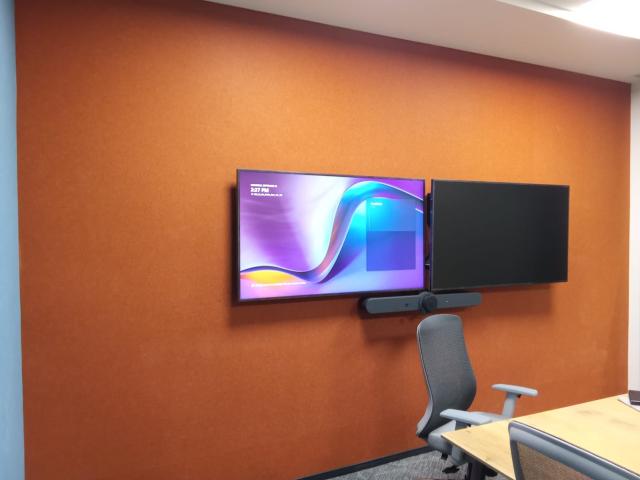Client Profile: A vibrant, open-plan commercial office located in a bustling urban area faced significant acoustic challenges due to its modern design. The office featured expansive, high ceilings and a mix of hard surfaces, such as concrete floors and glass walls, which contributed to noise disturbances, poor sound quality, and lack of privacy. The client sought a solution to improve the overall acoustic environment while preserving the sleek, open aesthetic of the office.
Challenges:
- High levels of noise caused by the combination of the open-plan layout and reflective hard surfaces.
- Reverberation and echoes, especially in areas with high foot traffic and large gatherings.
- Poor speech intelligibility in meetings and group discussions.
- A need for an acoustic solution that would complement the office’s contemporary design and not take away from the visual appeal.
Project Goal: The goal was to reduce the excessive noise levels, control sound reverberations, and enhance speech clarity in the open space while keeping the office's aesthetic intact. The solution had to address the acoustic challenges without compromising the spacious, modern feel of the interior.
Chosen Solution: To resolve the acoustic issues, Acoustic panels for ceiling were selected. These panels are specifically designed to reduce sound reflections from the ceiling and absorb sound waves, making them ideal for large, open spaces with high ceilings. Their ability to effectively manage noise without occupying floor space made them a perfect fit for this commercial office.
Implementation Process:
Acoustic Evaluation: A comprehensive assessment was carried out to identify areas where sound problems were most pronounced. The key focus was on the open areas with large expanses of hard surfaces that amplified noise, leading to echoes and high noise levels.
Panel Selection: The chosen ceiling acoustic panels were made from highly effective sound-absorbing materials such as fiberglass and mineral core boards. These panels are known for their excellent noise reduction qualities, especially in large spaces, and can absorb a broad spectrum of frequencies, including the mid-to-high range sounds that contribute to reverberation.
Design Consideration: The panels were custom-designed to complement the modern aesthetic of the office. They were available in a variety of sizes, patterns, and finishes, allowing for a cohesive design that would blend effortlessly with the office’s existing decor. The chosen design emphasized minimalism and functionality, ensuring that the panels would look as integrated as possible with the ceiling.
Strategic Installation: The ceiling panels were carefully installed in high-traffic and sound-reflective zones. The layout was planned to cover the majority of the ceiling’s surface while ensuring the overall design remained streamlined and unobtrusive. Panels were arranged in both grid and staggered patterns to maximize sound absorption across the entire space.
Installation Execution: Installation was done efficiently with minimal disruption to the daily office operations. The panels were mounted securely to the ceiling using appropriate fixtures, and the team ensured that the panels were evenly distributed for optimal performance. Special care was taken to avoid interference with existing lighting and ventilation systems.
Outcomes:
Noise Reduction: The ceiling panels significantly decreased noise levels across the open office. Employees noticed a calmer environment, which made it easier to focus and collaborate without distractions from background noise.
Enhanced Acoustics: The panels effectively reduced echoes and sound reflections, improving speech clarity during meetings and casual discussions. Conversations and phone calls became more intelligible, and there was less interference during virtual meetings.
Privacy Improvement: With less sound reflecting off the ceiling, employees gained better privacy for their conversations. The improved acoustics allowed for confidential discussions without worrying about being overheard in the open space.
Visual Integration: The ceiling panels blended seamlessly with the office’s contemporary design. The minimalistic >
Employee Experience: Employees reported an increase in comfort, as the reduced noise distractions made the workplace more conducive to both focused individual work and team collaboration. The improved acoustics also contributed to a more pleasant environment overall.
Client Feedback: The client was highly satisfied with the outcome of the acoustic treatment. The office’s acoustic issues were resolved, creating a much quieter and more comfortable working environment. Employees appreciated the improved speech clarity and reduction in noise distractions, while the client was pleased with the seamless integration of the panels into the existing design.
Conclusion: Ceiling-mounted acoustic panels offered an ideal solution to the noise and reverberation challenges in this open commercial space. The panels not only improved the acoustics by reducing sound reflections but also maintained the aesthetic integrity of the office. This case study demonstrates how an effective acoustic solution can transform a large, open office environment into a more comfortable, productive, and visually pleasing workspace, proving that functionality and design can go hand in hand.











